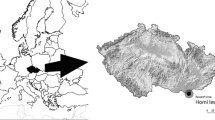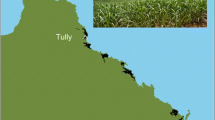Abstract
Internal checking and shrinkage are drying defects that strongly degrade timber for structural and appearance uses in many hardwood species. Wood quality assessors and tree breeders often measure checks and shrinkage from disc-derived wood wedges using scale-based methods and callipers, but these methods are subjective and labour intensive. This study developed an R-based open-source system using image thresholding techniques to quantify checks and shrinkage from digital images of wood wedges. The results showed that the automated quantification of checks predicted the subjective and manual assessment for both area and number of checks in Eucalyptus nitens at the wedge level, and provided much more precision than the subjective classification of checking used by breeders for little additional effort. Similarly, the automated image assessment explained a high proportion of the manually measured variation in shrinkage and collapse with little bias. The automated assessment resulted in significant time saving compared with the manual measurements from digital images. The R-based image analysis thus shows promise in replacing traditional assessment when evaluating a large number of samples and quantitative estimates of checks and shrinkage are required, and has the added advantage that the distribution of checks and collapse within the wedges can be obtained to assist diverse studies on drying defects.









Similar content being viewed by others
References
Ananias RA, Sepúlveda-Villarroel V, Pérez-Peña N et al (2014) Collapse of Eucalyptus nitens wood after drying depending on the radial location within the stem. Dry Technol 32:1699–1705. https://doi.org/10.1080/07373937.2014.924132
Australian/New Zealand Standards (2001) AS/NZS 4787—Timber Assessment of drying quality. SAI GLOBAL, Jointly published by Standards Australia International Ltd, GPO Box 5420, Sydney, NSW 2001 and Standards New Zealand, Private Bag 2439, Wellington 6020
Benítez R, Bolós VJ, Toca-Herrera JL (2017) Afmtoolkit: an R package for automated AFM force-distance curves analysis. R J 9:291
Blackburn DP, Hamilton M, Harwood C, Innes T, Potts B, Williams D (2010) Stiffness and checking of Eucalyptus nitens sawn boards: genetic variation and potential for genetic improvement. Tree Genet Genom 6:757–765. https://doi.org/10.1007/s11295-010-0289-7
Blakemore P (2011) Internal checking during eucalypt processing. In: Bucur V (ed) Delamination in wood, wood products and wood-based composites. Springer Netherlands, Dordrecht, pp 237–254. https://doi.org/10.1007/978-90-481-9550-3_12
Burdon RD, Kibblewhite RP, Walker JCF, Megraw RA, Evans R, Cown DJ (2004) Juvenile versus mature wood: A new concept, orthogonal to corewood versus outerwood, with special reference to Pinus radiata and P. taeda. For Sci 50:399–415
Chafe SC, Barnacle JE, Hunter AJ, Ilic J, Northway RL, Rozsa AN (1992) Collapse: an introduction. CSIRO Division of Forest Products, Melbourne
Funck JW, Zhong Y, Butler DA, Brunner CC, Forrer JB (2003) Image segmentation algorithms applied to wood defect detection. Comput Electron Agric 41:157–179. https://doi.org/10.1016/s0168-1699(03)00049-8
Gonya NAS (2020) An investigation into shrinkage and collapse behavior of Eucalyptus grandis and Eucalyptus grandis x urophylla wood. MSc Thesis, Dept of Forest and Wood Science, Stellenbosch University, South Africa
Hamilton MG, Raymond CA, Harwood CE, Potts BM (2009) Genetic variation in Eucalyptus nitens pulpwood and wood shrinkage traits. Tree Genet Genom 5:307–316. https://doi.org/10.1007/s11295-008-0179-4
Harris GA, Torgovnikov G, Vinden P, Brodie GI, Shaginov A (2008) Microwave pretreatment of backsawn messmate boards to improve drying quality: part 1. Dry Technol 26:579–584. https://doi.org/10.1080/07373930801944770
Hothorn T, Bretz F, Westfall P (2008) Simultaneous inference in general parametric models. Biom J 50:346–363. https://doi.org/10.1002/bimj.200810425
Ilic J (1999) Shrinkage-related degrade and its association with some physical properties in Eucalyptus regnans F-Muell. Wood Sci Technol 33:425–437. https://doi.org/10.1007/s002260050127
Innes TC (1995) Stress model of a wood fibre in relation to collapse. Wood Sci Technol 29:363–376. https://doi.org/10.1007/BF00202584
Innes TC (1996) Collapse and internal checking in the latewood of Eucalyptus regnans F Muell. Wood Sci Technol 30:373–383
Innes TC (2007) Processing and wood properties of four ages of Eucalyptus obliqua. Holz Roh Werkst 65:197–200. https://doi.org/10.1007/s00107-006-0138-4
Kamal K, Qayyum R, Mathavan S, Zafar T (2017) Wood defects classification using laws texture energy measures and supervised learning approach. Adv Eng Inform 34:125–135. https://doi.org/10.1016/j.aei.2017.09.007
Ke Z-N, Zhao Q-J, Huang C-H, Ai P, Yi J-G (2016) Detection of wood surface defects based on particle swarm-genetic hybrid algorithm. In: 2016 International Conference on Audio, Language and Image Processing (ICALIP), 2016. IEEE, pp 375–379
Lausberg M, Gilchrist K, Skipwith J (1995) Wood properties of Eucalyptus nitens grown in New Zealand. N Z J for Sci 25:147–163
Lenth R, Singmann H, Love J, Buerkner P, Herve M (2020) emmeans: Estimated Marginal Means, aka Least-Squares Means (Version 1.4.5)[Computer software]. https://CRAN.R-project.org/package=emmeans
McKenzie H, Turner J, Shelbourne C (2003) Processing young plantation-grown Eucalyptus nitens for solid-wood products. 1: individual-tree variation in quality and recovery of appearance-grade lumber and veneer. N Z J for Sci 33:62–78
Mekhtiev MA, Torgovnikov GI (2004) Method of check analysis of microwave-modified wood. Wood Sci Technol 38:507–519. https://doi.org/10.1007/s00226-004-0259-z
Pau G, Fuchs F, Sklyar O, Boutros M, Huber W (2010) EBImage-an R package for image processing with applications to cellular phenotypes. Bioinformatics 26:979–981. https://doi.org/10.1093/bioinformatics/btq046
Phonetip K, Ozarska B, Brodie GI (2017) Comparing two internal check measurement methods for wood drying quality assessment. Eur J Wood Prod 75:139–142. https://doi.org/10.1007/s00107-016-1115-1
Purnell R (1988) Variation in wood properties of Eucalyptus nitens in a provenance trial on the eastern Transvaal Highveld in South Africa. S Afr for J 144:10–22
R Core Team (2020) R: a language and environment for statistical computing. R Foundation for Statistical Computing, Vienna
Rahiddin RNN, Hashim UR, Ismail NH, Salahuddin L, Choon NH, Zabri SN (2020) Classification of wood defect images using local binary pattern variants. Int J Adv Intell Inform 6:36–45. https://doi.org/10.26555/ijain.v6i1.392
Rebolledo P, Salvo L, Contreras H, Cloutier A, Ananias RA (2013) Variation of internal checks related to anatomical structure and density in Eucalyptus nitens wood. Wood Fiber Sci 45:279–286
Sargent R (2019) Evaluating dimensional stability in solid wood: a review of current practice. J Wood Sci 65:11. https://doi.org/10.1186/s10086-019-1817-1
Schneider CA, Rasband WS, Eliceiri KW (2012) NIH Image to ImageJ: 25 years of image analysis. Nat Methods 9:671–675. https://doi.org/10.1038/nmeth.2089
Shelbourne CJA, Nicholas ID, McKinley RB, Low CB, McConnochie RM, Lausberg MJF (2002) Wood density and internal checking of young Eucalyptus nitens in New Zealand as affected by site and height up the tree. N Z J for Sci 32:357–385
Shi JH, Li ZY, Zhu TT, Wang DY, Ni C (2020) Defect detection of industry wood veneer based on NAS and multi-channel mask R-CNN. Sensors 20:17. https://doi.org/10.3390/s20164398
Sterratt D, Vihtakari M (2015) RImageJROI: Read ‘ImageJ’Region of Interest (ROI) Files. Available at: https://github.com/davidcsterratt/RImageJROI
Todoroki CL, Lowell EC, Dykstra D (2010) Automated knot detection with visual post-processing of Douglas-fir veneer images. Comput Electron Agric 70:163–171. https://doi.org/10.1016/j.compag.2009.10.002
Urbonas A, Raudonis V, Maskeliunas R, Damasevicius R (2019) Automated identification of wood veneer surface defects using faster region-based convolutional neural network with data augmentation and transfer learning. Appl Sci-Basel 9:20. https://doi.org/10.3390/app9224898
Vega M, Hamilton M, Downes G, Harrison PA, Potts B (2020) Radial variation in modulus of elasticity, microfibril angle and wood density of veneer logs from plantation-grown Eucalyptus nitens. Ann for Sci 77:65. https://doi.org/10.1007/s13595-020-00961-1
Walker JCF (2006) Primary wood processing: Principles and practice vol 9781402043932. In: Primary Wood Processing: Principles and Practice. Springer, Berlin. https://doi.org/10.1007/1-4020-4393-7
Washusen R, Harwood C, Morrow A et al (2009) Pruned plantation-grown Eucalyptus nitens: effect of thinning and conventional processing practices on sawn board quality and recovery. N Z J for Sci 39:39–55
Wells RE, Barry JD, Warrington SJ et al (2013) Control of tissue morphology by Fasciclin III-mediated intercellular adhesion. Development 140:3858–3868. https://doi.org/10.1242/dev.096214
Yang L, Liu HH (2018) A review of Eucalyptus wood collapse and its control during drying. BioResources 13:2171–2181. https://doi.org/10.15376/biores.13.1.Yang
Yang JL, Ilic J, Evans R, Fife D (2003) Interrelationships between shrinkage properties, microfibril angle, and cellulose crystallite width in 10-year-old Eucalyptus globulus. N Z J for Sci 33:47–61
Yuniarti K, Ozarska B, Brodie G, Harris G, Waugh G (2015) Collapse development of Eucalyptus saligna under different drying temperatures. J Trop for Sci 27:462–471
Zúñiga LL, Ananias RA, Cloutier A, Díaz-vaz JE, Bermedo M, Sanhueza R, Lasserre JP (2008) Preliminary study of internal checks within growth-rings and their relationship with anatomical features and density in Eucalyptus nitens. Interciencia 33:829–834
Acknowledgements
The authors would like to acknowledge STT (Sustainable Timber Tasmania) managers Jhon McNamara and David White for providing access to the trials and allowing sample collection from selected trees. The authors would like to thank Meagan Porter (School of Natural Sciences and ARC Industrial Transformation Training Centre, University of Tasmania) for performing manual assessment on digital images, and Dr. Thomas Baker and Hugh Fitzgerald (School of Natural Sciences and ARC Industrial Transformation Training Centre, University of Tasmania) for assisting in the fieldwork activities. Thanks to Dr. Phillip Blacklow (School of Creative Arts and Media, University of Tasmania) for his technical support with the wood sample processing.
Funding
The research was founded by the Australian Research Council Industrial Transformation Training Centre grant ICI150100004 for supporting this project.
Author information
Authors and Affiliations
Corresponding author
Ethics declarations
Conflict of interest
The authors declare that they have no conflict of interest.
Additional information
Publisher's Note
Springer Nature remains neutral with regard to jurisdictional claims in published maps and institutional affiliations.
Rights and permissions
About this article
Cite this article
Rocha-Sepúlveda, M.F., Vega, M., Gendvilas, V. et al. R-based image analysis to quantify checking and shrinkage from wood wedges. Eur. J. Wood Prod. 79, 1269–1281 (2021). https://doi.org/10.1007/s00107-021-01715-0
Received:
Accepted:
Published:
Issue Date:
DOI: https://doi.org/10.1007/s00107-021-01715-0




